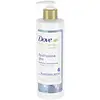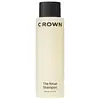What's inside
What's inside
 Key Ingredients
Key Ingredients

 Benefits
Benefits

 Concerns
Concerns

 Ingredients Side-by-side
Ingredients Side-by-side

Water
Skin ConditioningCocamidopropyl Betaine
CleansingSodium Methyl Cocoyl Taurate
CleansingSodium Chloride
MaskingGlycerin
HumectantHydrolyzed Hyaluronic Acid
HumectantGluconolactone
Skin ConditioningCitric Acid
BufferingSodium Benzoate
MaskingGlycol Distearate
EmollientParfum
MaskingCoconut Acid
CleansingStearamidopropyl Dimethylamine
EmulsifyingPolyquaternium-10
Disodium EDTA
PPG-9
Skin ConditioningBenzyl Salicylate
PerfumingHexyl Cinnamal
PerfumingLimonene
PerfumingLinalool
PerfumingWater, Cocamidopropyl Betaine, Sodium Methyl Cocoyl Taurate, Sodium Chloride, Glycerin, Hydrolyzed Hyaluronic Acid, Gluconolactone, Citric Acid, Sodium Benzoate, Glycol Distearate, Parfum, Coconut Acid, Stearamidopropyl Dimethylamine, Polyquaternium-10, Disodium EDTA, PPG-9, Benzyl Salicylate, Hexyl Cinnamal, Limonene, Linalool
Water
Skin ConditioningLauramidopropyl Hydroxysultaine
CleansingSodium Laurylglucosides Hydroxypropylsulfonate
CleansingCocamidopropyl Hydroxysultaine
CleansingSodium Cocoyl Sarcosinate
CleansingDisodium Lauryl Sulfosuccinate
CleansingGlycerin
HumectantEthyltrimonium Chloride Methacrylate/Hydrolyzed Wheat Protein Copolymer
Parfum
MaskingCamellia Japonica Seed Oil
EmollientIsodecyl Neopentanoate
EmollientGluconolactone
Skin ConditioningSodium Benzoate
MaskingCalcium Gluconate
HumectantCitric Acid
BufferingWater, Lauramidopropyl Hydroxysultaine, Sodium Laurylglucosides Hydroxypropylsulfonate, Cocamidopropyl Hydroxysultaine, Sodium Cocoyl Sarcosinate, Disodium Lauryl Sulfosuccinate, Glycerin, Ethyltrimonium Chloride Methacrylate/Hydrolyzed Wheat Protein Copolymer, Parfum, Camellia Japonica Seed Oil, Isodecyl Neopentanoate, Gluconolactone, Sodium Benzoate, Calcium Gluconate, Citric Acid
Ingredients Explained
These ingredients are found in both products.
Ingredients higher up in an ingredient list are typically present in a larger amount.
Citric Acid is an alpha hydroxy acid (AHA) naturally found in citrus fruits like oranges, lemons, and limes.
Like other AHAs, citric acid can exfoliate skin by breaking down the bonds that hold dead skin cells together. This helps reveal smoother and brighter skin underneath.
However, this exfoliating effect only happens at high concentrations (20%) which can be hard to find in cosmetic products.
Due to this, citric acid is usually included in small amounts as a pH adjuster. This helps keep products slightly more acidic and compatible with skin's natural pH.
In skincare formulas, citric acid can:
While it can provide some skin benefits, research shows lactic acid and glycolic acid are generally more effective and less irritating exfoliants.
Most citric acid used in skincare today is made by fermenting sugars (usually from molasses). This synthetic version is identical to the natural citrus form but easier to stabilize and use in formulations.
Read more about some other popular AHA's here:
Learn more about Citric AcidGluconolactone is a PHA. PHAs are a great gentle alternative to traditional AHAs.
When applied, Gluconolactone has the same affect on skin as AHAs such as lactic acid. It helps dissolve the dead skin cells in the top layer of your skin. This improves texture and brightens the skin.
PHAs are more gentle than AHAs due to their larger structure. They do not penetrate as deeply as AHAs and take a longer time to dissolve dead cells. Studies show PHAs do not cause as much irritation.
Gluconolactone has some interesting properties:
In a 2004 study, Gluconolactone was found to prevent UV damage in mouse skin cells and has not been found to increase sun sensitivity. However, we still recommend wearing SPF daily.
This ingredient is is an created by reacting gluconic acid with an alcohol.
Learn more about GluconolactoneGlycerin is already naturally found in your skin. It helps moisturize and protect your skin.
A study from 2016 found glycerin to be more effective as a humectant than AHAs and hyaluronic acid.
As a humectant, it helps the skin stay hydrated by pulling moisture to your skin. The low molecular weight of glycerin allows it to pull moisture into the deeper layers of your skin.
Hydrated skin improves your skin barrier; Your skin barrier helps protect against irritants and bacteria.
Glycerin has also been found to have antimicrobial and antiviral properties. Due to these properties, glycerin is often used in wound and burn treatments.
In cosmetics, glycerin is usually derived from plants such as soybean or palm. However, it can also be sourced from animals, such as tallow or animal fat.
This ingredient is organic, colorless, odorless, and non-toxic.
Glycerin is the name for this ingredient in American English. British English uses Glycerol/Glycerine.
Learn more about GlycerinParfum is a catch-all term for an ingredient or more that is used to give a scent to products.
Also called "fragrance", this ingredient can be a blend of hundreds of chemicals or plant oils. This means every product with "fragrance" or "parfum" in the ingredients list is a different mixture.
For instance, Habanolide is a proprietary trade name for a specific aroma chemical. When used as a fragrance ingredient in cosmetics, most aroma chemicals fall under the broad labeling category of “FRAGRANCE” or “PARFUM” according to EU and US regulations.
The term 'parfum' or 'fragrance' is not regulated in many countries. In many cases, it is up to the brand to define this term.
For instance, many brands choose to label themselves as "fragrance-free" because they are not using synthetic fragrances. However, their products may still contain ingredients such as essential oils that are considered a fragrance by INCI standards.
One example is Calendula flower extract. Calendula is an essential oil that still imparts a scent or 'fragrance'.
Depending on the blend, the ingredients in the mixture can cause allergies and sensitivities on the skin. Some ingredients that are known EU allergens include linalool and citronellol.
Parfum can also be used to mask or cover an unpleasant scent.
The bottom line is: not all fragrances/parfum/ingredients are created equally. If you are worried about fragrances, we recommend taking a closer look at an ingredient. And of course, we always recommend speaking with a professional.
Learn more about ParfumSodium Benzoate is a preservative. It's used in both cosmetic and food products to inhibit the growth of mold and bacteria. It is typically produced synthetically.
Both the US FDA and EU Health Committee have approved the use of sodium benzoate. In the US, levels of 0.1% (of the total product) are allowed.
Sodium benzoate works as a preservative by inhibiting the growth of bacteria inside of cells. It prevents the cell from fermenting a type of sugar using an enzyme called phosphofructokinase.
It is the salt of benzoic acid. Foods containing sodium benzoate include soda, salad dressings, condiments, fruit juices, wines, and snack foods.
Studies for using ascorbic acid and sodium benzoate in cosmetics are lacking, especially in skincare routines with multiple steps.
We always recommend speaking with a professional, such as a dermatologist, if you have any concerns.
Learn more about Sodium BenzoateWater. It's the most common cosmetic ingredient of all. You'll usually see it at the top of ingredient lists, meaning that it makes up the largest part of the product.
So why is it so popular? Water most often acts as a solvent - this means that it helps dissolve other ingredients into the formulation.
You'll also recognize water as that liquid we all need to stay alive. If you see this, drink a glass of water. Stay hydrated!
Learn more about Water